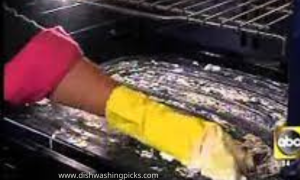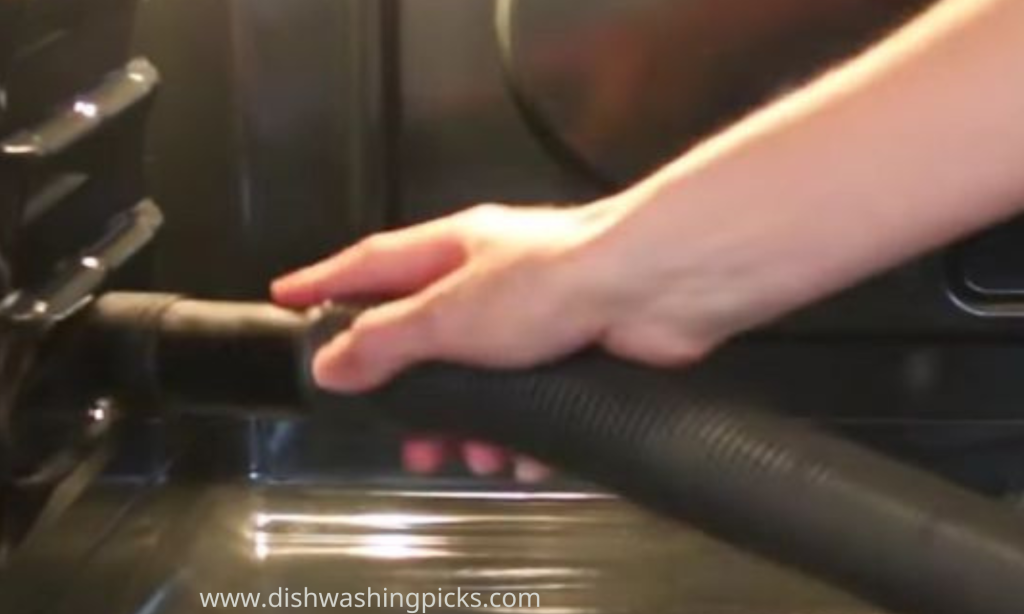Maintaining a clean and efficient dishwasher is essential for ensuring your dishes come out spotless and free from residue. While vinegar has long been a popular choice for dishwasher cleaning, it’s not the only solution. In this guide, we’ll explore effective methods for cleaning your dishwasher without vinegar. Whether you’re looking for alternatives due to allergies, dislike the vinegar smell, or simply want to try something new, we’ve got you covered. Discover the secrets to keeping your dishwasher in pristine condition while avoiding vinegar in the process.
Step-by-Step Guide: how to clean a dishwasher without vinegar
Let’s roll up our sleeves and get down to the nitty-gritty of cleaning your dishwasher without vinegar. Whether you’re a vinegar-averse individual or just looking for alternative cleaning methods, we’ve got you covered:
Baking Soda and Dish Soap
Mixing the Solution: Start by combining 1/4 cup of baking soda with 1/4 cup of dish soap. Mix it until you have a paste-like consistency.
Applying the Mixture: Take a soft cloth or sponge and dip it into the paste you’ve just made. Then, gently scrub the interior of your dishwasher. Pay close attention to the spray arm, racks, and the door. This mixture will help break down grease and grime.
Running a Cycle
Once you’ve given your dishwasher’s interior a good scrub, it’s time to put it to work. Load a cup of white vinegar on the top rack and run a hot water cycle. This will help rinse away any remaining residue and leave your dishwasher smelling fresh.
Lemon and Salt
Preparing the Lemon Solution: Slice a fresh lemon in half and sprinkle a tablespoon of salt on the fleshy side of one half. This natural combo will help to scrub and deodorize your dishwasher.
Applying the Lemon Solution: Place the lemon half with salt on the top rack of your empty dishwasher. You can also add some lemon zest for extra fragrance. Run a hot water cycle, and let the lemony goodness work its magic.
Hydrogen Peroxide
Mixing the Hydrogen Peroxide Solution: In a bowl, combine 1/2 cup of hydrogen peroxide with a cup of water.
Applying the Solution: Pour the hydrogen peroxide mixture into a dishwasher-safe container or cup and place it on the top rack. Run a hot water cycle. The hydrogen peroxide will help to sanitize and remove stains.
Citric Acid
Citric Acid Preparing the Citric Acid Solution: Mix 1/4 cup of citric acid with a quart of water to create your cleaning solution.
Applying the Solution: Pour the citric acid mixture into the detergent dispenser of your dishwasher.
Run a hot water cycle. Citric acid is excellent at breaking down hard water deposits and limescale.
After using any of these methods, you’ll notice a fresher, cleaner dishwasher ready to tackle your dirty dishes effectively.
Remember, regular maintenance is the key to a trouble-free dishwasher. By using these vinegar-free cleaning techniques and keeping up with maintenance, you’ll have a sparkling dishwasher that keeps your dishes gleaming. Happy dishwashing.

Imagine this: you open your dishwasher only to find the remnants of last night’s dinner still clinging to your dishes. Not the most pleasant sight, right? To avoid such disappointments, it’s crucial to prepare your dishwasher properly before embarking. Here’s how:
Safety Precautions
Before you start knowing how to clean a dishwasher without vinegar, remember to unplug your dishwasher or turn off its power source. Safety first! You don’t want any accidental mishaps while you’re elbow-deep in cleaning.
Emptying the Dishwasher
Begin by completely emptying your dishwasher. This includes removing any dirty dishes, racks, and utensil baskets. This gives you unobstructed access to every nook and cranny that needs cleaning.
Removing Food Debris
Take a moment to clear any visible food debris. It’s a good idea to wear gloves for this part, especially if things are a bit gunky. Check the dishwasher’s filter, located at the bottom of the appliance.
Remove it and rinse it under warm, soapy water to clear out any trapped debris. This simple step can significantly improve your dishwasher’s performance.
By taking these preparatory steps, you’re ensuring that your dishwasher is ready to receive the cleaning treatment it deserves.
A clean slate is the first step towards a cleaner, more efficient appliance. It might not be the most glamorous part of the process, but it’s a necessary one.
Maintaining your dishwasher is like taking care of a trusty friend who always has your back. With a little regular TLC, you can ensure it keeps working efficiently and reliably. Let’s go through the steps to help you maintain a sparkling clean dishwasher:
Regular Cleaning Schedule
Just like any good friendship, consistency is the key. Make it a habit to clean your dishwasher every 1-2 months, depending on how frequently you use it. Regular cleaning prevents the buildup of grime and odors, keeping your dishes spotless.
Preventing Future Build-Up
To minimize future messes, scrape off food scraps from your dishes before loading them. This simple step reduces the amount of debris that can accumulate in the dishwasher. And don’t forget to rinse your dishwasher filter regularly under warm, soapy water to keep it functioning optimally.
Tips for Optimal Dishwasher Performance
After learning how to clean the dishwasher without vinegar, there are some tips that you should follow:
Inspect the spray arms: Check the spray arms for any clogs or debris. Remove them if necessary and rinse them under warm water.
Pay attention to the seals: Inspect the door seal for any signs of damage or buildup. Wipe it down to keep it clean and ensure a tight seal during cycles.
Use the right detergent: Always use dishwasher detergent. Regular dish soap can lead to excessive suds and leave a soapy residue behind.
Run hot water before starting a cycle: Let hot water run from your kitchen faucet before starting a cycle. This ensures that the dishwasher begins with hot water right away, enhancing its cleaning efficiency.
Maintain water temperature: Make sure your dishwasher’s water temperature is set to an adequate level. Around 120-150°F (49-65°C) is ideal for the best cleaning results.
Don’t overload: Avoid cramming too many dishes into a single load. Overloading can result in poor cleaning performance.
Empty the dishwasher promptly: Once a cycle is finished, empty the dishwasher as soon as possible. This prevents moisture and odors from lingering.
By following these maintenance tips, you’re not just ensuring your dishwasher remains in tip-top shape; you’re also prolonging its lifespan and making sure it continues to serve you with squeaky clean dishes for years to come.
It’s a win-win situation for you and your dependable kitchen companion.
Troubleshooting Common Issues
Every relationship has its ups and downs, and your relationship with your dishwasher is no exception. Sometimes, it might show signs of trouble, but don’t worry; we’re here to help you troubleshoot those common issues. Let’s tackle them one by one:
Dealing with Odor Problems
Odors in your dishwasher can make the kitchen an unwelcome place. To tackle this, follow these steps:
Examine the filter: Start by checking the dishwasher’s filter for trapped food debris. Give it a good rinse and make sure it’s clean.
Run a vinegar wash: Place a cup of white vinegar on the top rack and run a hot water cycle. The vinegar will help neutralize odors.
Lemon freshness: For a natural, citrusy aroma, you can also place a fresh lemon on the top rack and run a hot water cycle. It works wonders in combating unpleasant smells.
Addressing Limescale Build-Up
Limescale can clog your dishwasher’s nozzles and reduce efficiency. Here’s how to combat it:
Inspect and clean the spray arms: Remove the spray arms and check for any limescale build-up. Soak them in white vinegar for an hour and scrub gently to remove deposits.
Dishwasher cleaner: Consider using a dishwasher cleaner specifically designed to tackle limescale. Follow the manufacturer’s instructions for optimal results.
Tackling Persistent Stains
Stains on your glassware and dishes can be frustrating, but there’s a remedy:
Check the spray arms: As mentioned earlier, limescale can be a culprit for stained dishes. Ensure the spray arms are clean and free from blockages.
Adjust your detergent: You might need to experiment with different dishwasher detergents to find one that works best for your water hardness. High-quality detergents can make a significant difference.
Pre-soaked stained dishes: If you have particularly stubborn stains, consider pre-soaking your dishes before loading them into the dishwasher.
After our article, we talked about how to clean the dishwasher without vinegar common issues with a little patience and care, you’ll keep your dishwasher running smoothly, and it will continue to be your reliable kitchen companion. Remember, it’s all about maintaining a happy and efficient partnership with your trusty appliance.

